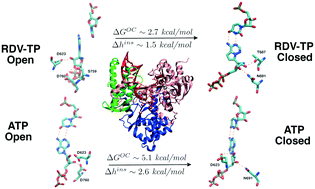Probing remdesivir nucleotide analogue insertion to SARS-CoV-2 RNA dependent RNA polymerase in viral replication†
Abstract
Remdesivir (RDV) prodrug can be metabolized into a triphosphate form nucleotide analogue (RDV-TP) to bind and insert into the active site of viral RNA dependent RNA polymerase (RdRp) to further interfere with viral genome replication. In this work, we computationally studied how RDV-TP binds and inserts to the SARS-CoV-2 RdRp active site, in comparison with natural nucleotide substrate adenosine triphosphate (ATP). To do that, we first constructed atomic structural models of an initial binding complex (active site open) and a substrate insertion complex (active site closed), based on high-resolution cryo-EM structures determined recently for SARS-CoV-2 RdRp or non-structural protein (nsp) 12, in complex with accessory protein factors nsp7 and nsp8. By conducting all-atom molecular dynamics simulation with umbrella sampling strategies on the nucleotide insertion between the open and closed state RdRp complexes, our studies show that RDV-TP can initially bind in a comparatively stabilized state to the viral RdRp active site, as it primarily forms base stacking with the template uracil nucleotide (nt +1), which under freely fluctuations supports a low free energy barrier of the RDV-TP insertion (∼1.5 kcal mol−1). In comparison, the corresponding natural substrate ATP binds initially to the RdRp active site in Watson–Crick base pairing with the template nt, and inserts into the active site with a medium low free energy barrier (∼2.6 kcal mol−1), when the fluctuations of the template nt are well quenched. The simulations also show that the initial base stacking of RDV-TP with the template can be specifically stabilized by motif C-S759, S682 (near motif B) with the base, and motif G-K500 with the template backbone. Although the RDV-TP insertion can be hindered by motif F-R555/R553 interaction with the triphosphate, the ATP insertion seems to be facilitated by such interactions. The inserted RDV-TP and ATP can be further distinguished by specific sugar interaction with motif B-T687 and motif A-D623, respectively.

- This article is part of the themed collections: Coronavirus articles - free to access collection and Molecular design for COVID-19


 Please wait while we load your content...
Please wait while we load your content...
